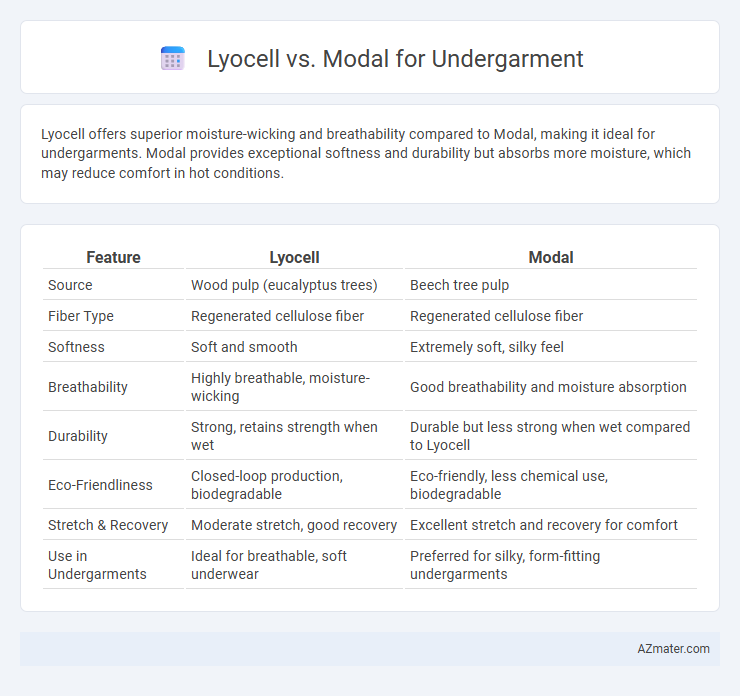Lyocell offers superior moisture-wicking and breathability compared to Modal, making it ideal for undergarments. Modal provides exceptional softness and durability but absorbs more moisture, which may reduce comfort in hot conditions.
Table of Comparison
| Feature | Lyocell | Modal |
|---|---|---|
| Source | Wood pulp (eucalyptus trees) | Beech tree pulp |
| Fiber Type | Regenerated cellulose fiber | Regenerated cellulose fiber |
| Softness | Soft and smooth | Extremely soft, silky feel |
| Breathability | Highly breathable, moisture-wicking | Good breathability and moisture absorption |
| Durability | Strong, retains strength when wet | Durable but less strong when wet compared to Lyocell |
| Eco-Friendliness | Closed-loop production, biodegradable | Eco-friendly, less chemical use, biodegradable |
| Stretch & Recovery | Moderate stretch, good recovery | Excellent stretch and recovery for comfort |
| Use in Undergarments | Ideal for breathable, soft underwear | Preferred for silky, form-fitting undergarments |
Introduction to Lyocell and Modal Fabrics
Lyocell and Modal are both cellulose-based fibers derived from wood pulp, commonly used in undergarments for their softness and breathability. Lyocell is produced through a closed-loop process that is environmentally friendly, known for its strong moisture-wicking properties and smooth texture. Modal, a type of rayon, offers excellent stretch and durability with a silky feel, making it ideal for comfortable, form-fitting underwear.
Origins and Production Processes
Lyocell is made from sustainably sourced eucalyptus wood pulp through a closed-loop solvent spinning process that recycles water and solvents, minimizing environmental impact. Modal originates from beech tree pulp and is produced using a chemical-intensive process involving alkali and carbon disulfide, which raises concerns about toxicity and pollution. Both fibers offer soft textures ideal for undergarments, but Lyocell's eco-friendly production makes it a preferred choice for environmentally conscious consumers.
Environmental Impact Comparison
Lyocell and modal fibers both derive from cellulose but differ significantly in environmental impact for undergarments. Lyocell production uses a closed-loop process that recycles solvents and consumes less water, resulting in lower toxicity and minimal emissions, enhancing its eco-friendly profile. Modal involves more chemical use and water consumption, with conventional processing often leading to higher environmental strain despite its softness and durability.
Comfort and Softness Ratings
Lyocell and Modal fibers both excel in comfort and softness, making them popular choices for undergarments, with Lyocell praised for its smooth, breathable texture and moisture-wicking properties that enhance skin comfort. Modal offers superior softness due to its finer fibers and higher tensile strength, contributing to durability and a silky feel against the skin. Consumer comfort ratings often favor Modal for softness, while Lyocell is preferred for breathability and all-day comfort in sensitive skin applications.
Breathability and Moisture-Wicking Properties
Lyocell fibers exhibit superior breathability and moisture-wicking properties due to their smooth surface and high absorbency, making them ideal for undergarments that require effective moisture management and comfort. Modal, while also breathable and moisture-wicking, tends to be softer but less durable when exposed to frequent washing and has slightly lower moisture absorption compared to Lyocell. Both materials promote skin dryness and temperature regulation, but Lyocell's eco-friendly production and enhanced breathability offer a significant advantage in performance underwear.
Durability and Longevity
Lyocell offers superior durability in undergarments due to its strong fiber structure and resistance to abrasion, ensuring longer wear without losing shape or softness. Modal provides excellent longevity as well, with its smooth texture maintaining softness after multiple washes, though it is slightly less robust compared to Lyocell. Choosing Lyocell enhances durability for everyday undergarments, while Modal balances comfort with reasonable lifespan.
Skin Sensitivity and Hypoallergenic Features
Lyocell and modal fibers are both highly regarded for their softness and breathability, making them ideal for undergarments worn against sensitive skin. Lyocell, derived from eucalyptus trees through an eco-friendly process, offers excellent moisture-wicking properties and is naturally hypoallergenic, reducing the risk of irritation and allergic reactions. Modal, produced from beech tree pulp, provides a smooth, silky texture that enhances comfort while promoting breathability and resistance to shrinking, ensuring gentle care for delicate skin.
Care and Maintenance Requirements
Lyocell undergarments require gentle washing in cold water to maintain fiber strength and prevent shrinkage, while avoiding bleach and high heat drying preserves fabric integrity. Modal underwear benefits from similar care, with preference for delicate cycles and low-temperature tumble drying to retain softness and elasticity. Both fibers degrade less with proper washing techniques, extending garment life and comfort.
Cost Differences and Value for Money
Lyocell undergarments typically cost more than Modal due to their eco-friendly production process and higher durability, offering long-term savings despite the initial price. Modal fabrics are often less expensive, providing soft comfort and breathability but may wear out faster, reducing overall value for money. Consumers seeking sustainable, high-performance undergarments might find Lyocell a better investment despite the higher upfront cost.
Lyocell vs Modal: Which is Best for Undergarments?
Lyocell and Modal are both sustainable fabrics derived from wood pulp but differ in fiber structure and moisture management, impacting undergarment comfort. Lyocell offers superior breathability and moisture-wicking properties, making it ideal for sensitive skin and active wear due to its smooth, durable fibers that resist shrinking and pilling. Modal provides a softer, more luxurious feel with excellent stretch and color retention, but it is less moisture absorbent than Lyocell, which can affect overall freshness and comfort in undergarments worn for extended periods.

Infographic: Lyocell vs Modal for Undergarment
 azmater.com
azmater.com